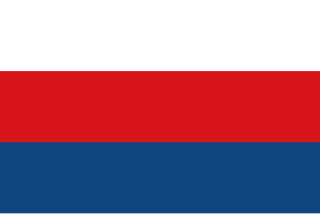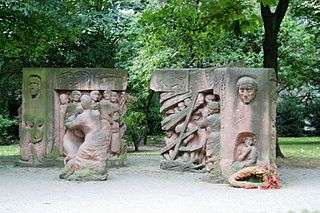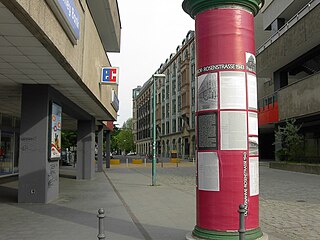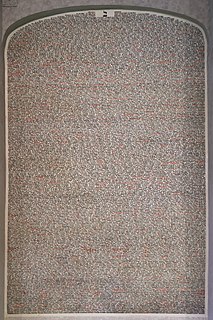Related Research Articles

The Protectorate of Bohemia and Moravia was a partially annexed territory of Nazi Germany established on 16 March 1939 following the German occupation of the Czech lands on 15 March 1939. Earlier, following the Munich Agreement of September 1938, Nazi Germany had incorporated the Czech Sudetenland territory as a Reichsgau.

The ghetto uprisings during World War II were a series of armed revolts against the regime of Nazi Germany between 1941 and 1943 in the newly established Jewish ghettos across Nazi-occupied Europe. Following the German and Soviet invasion of Poland in September 1939, Polish Jews were targeted from the outset. Within months inside occupied Poland, the Germans created hundreds of ghettos in which they forced the Jews to live. The new ghettos were part of the German official policy of removing Jews from public life with the aim of economic exploitation. The combination of excess numbers of inmates, unsanitary conditions and lack of food resulted in a high death rate among them. In most cities the Jewish underground resistance movements developed almost instantly, although ghettoization had severely limited their access to resources.
Mischling was a pejorative legal term used in Nazi Germany to denote persons of both Aryan and non-Aryan, such as Jewish ancestry as codified in the Nuremberg racial laws of 1935. In German, the word has the general denotation of hybrid, mongrel, or half-breed. Outside its use in official Nazi terminology, the term Mischlingskinder was later used to refer to war babies born to non-white soldiers and German mothers in the aftermath of World War II.

The Rosenstrasse protest on Rosenstraße in Berlin took place during February and March 1943. This demonstration was initiated and sustained by the non-Jewish wives and relatives of Jewish men and mischling who had been arrested and targeted for deportation, based on the racial policy of Nazi Germany. The protests, which occurred over the course of seven days, continued until the men being held were released. The Rosenstrasse protest is considered to be a significant event in German history as it is the only mass public demonstration by Germans in the Third Reich against the deportation of Jews. In describing the protests, German Foreign Minister Joschka Fischer states, "There were demonstrations, public protests against random arrests, - first dozens, then hundreds, then thousands of women, who demanded in unison "Give us back our men!" This lasted a whole week, in icy weather, in the middle of Berlin in 1943. Finally the protest by the women of the Rosenstrasse, furiously desperate and undeterred by any threats, made the Nazi regime retreat. 1,700 Berlin Jews, whom the Gestapo in their so-called "final action" had herded together into the Jewish community house on Rosenstrasse near Alexanderplatz, were freed."

Miroslav Kárný was an historian and writer from Prague, Czechoslovakia.

The Fabrikaktion is the term for the roundup of the last Jews to be deported from Berlin starting 27 February 1943. Most of these remaining Jews were working at Berlin plants or for the Jewish welfare organization. The term was coined by the victims after World War II, the Gestapo called the plan "Große Fabrik-Aktion". While the plan was not restricted to Berlin, it later became most notable for ensuring the Rosenstrasse protest in Berlin.
As part of the „Arbeitsscheu Reich“(work-shy Reich) in April and in June 1938 in two waves of arrests more than 10,000 men as so-called "black triangle anti-social elements" to concentration camps. During the so-called June-action were also arrested about 2,500 Jews who had received previous convictions for varied reasons.
Benjamin Frommer is an American historian, focused on history of Central Europe in 20th century. His work has concerns topics of genocide and ethnic cleansing, collaboration and resistance, transitional justice, and Central/Eastern European nationalism. Much of his work focuses on The Protectorate of Bohemia and Moravia. He is currently the Charles Deering McCormick Professor and was formerly the Wayne V. Jones Research Professor of History at Northwestern University. He is fluent in Czech, French, German, and Slovak and has reading knowledge of Russian.
During the National Socialist era, "Aryan persons" who lived in so-called mixed marriages with a "Jewish person" were referred to as "jüdisch versippt". "Jüdisch Versippte" were discriminated against; they were excluded from certain professions and career opportunities, dismissed from public service, and from 1943 were deemed as "unworthy of military service" and were used for quartered forced labor in "Sonderkommandos" of the Organization Todt.

The Holocaust in the Protectorate of Bohemia and Moravia resulted in the deportation, dispossession, and death of 80,000 Jews. It was carried out by Nazi Germany, which was occupying the country.

The Holocaust in the Sudetenland resulted in the flight, dispossession, deportation and ultimately death of many of the 24,505 Jews living in the Reichsgau Sudetenland, a Nazi German administrative region established from former Czechoslovak territory annexed after the October 1938 Munich Agreement. Due to harassment and violence, including during Kristallnacht, ninety percent of the Jews had already left the Sudetenland by mid-1939. The remaining Jews were subject to property confiscation and eventually deportation. During the later years of the war, tens of thousands of Jews and non-Jews were forced laborers in a network of concentration camps in the Sudetenland.

Arijský boj was a pro-Nazi Czech-language weekly tabloid newspaper published between May 1940 and May 1945 in the Protectorate of Bohemia and Moravia. Inspired by Der Stürmer, the newspaper made antisemitism its main theme and was also critical of the Czechoslovak government-in-exile. Denunciations published by the newspaper contributed to the isolation of Jews during the first years of the Holocaust in Bohemia and Moravia.

The Persecution and Murder of the European Jews by Nazi Germany, 1933–1945 is a book series that contains documents relating to the Holocaust, edited and translated, with scholarly introductions by historians. Since 2008, thirteen volumes have been published in German, with three pending; the first two volumes have also been published in English. The third English volume is scheduled for publication in 2020.
The Greater German Reich and the Jews: Nazi Persecution Policies in the Annexed Territories 1935–1945 is a book about the Holocaust in areas annexed by Nazi Germany. The book's chapters are arranged in chronological order by annexation date and cover the Saarland, Austria, the Sudetenland, Protectorate of Bohemia and Moravia, Memel Territory, Danzig and West Prussia, the Warthegau, Zichenau, East Upper Silesia, Eupen-Malmedy, Luxembourg, and Alsace-Lorraine. It was first published in German in 2010; an English translation was published in 2015. The book was edited by Jörg Osterloh and Wolf Gruner. The book received generally favorable reviews.

The Holocaust in Bohemia and Moravia: Czech Initiatives, German Policies, Jewish Responses is a book by the German historian Wolf Gruner on the Holocaust in Bohemia and Moravia, the Czech-majority parts of Czechoslovakia partially annexed into Nazi Germany during the German occupation of Czechoslovakia. Beginning before the Munich Agreement, Gruner's book covers the various stages of persecution of Jews which led to their deportation and murder. He argues that the role of Czech collaboration and local initiatives was greater than has been conventionally assumed, and also that Jewish resistance to persecution was substantial. The book has received mixed reviews; some Czech historians have disagreed with Gruner's conclusions while other reviewers generally praised the book with some reservations. The book was published in German in 2016 and in English and Czech in 2019. It received the 2017 Sybil Halpern Milton Memorial Book Prize of the German Studies Association.
Organization Schmelt was a Nazi SS organization that ran a system of forced-labor camps with mostly Jewish prisoners. It originated in East Upper Silesia, but spread to the Sudetenland and other areas. Many of its camps were later absorbed into concentration camp systems such as Auschwitz and Gross-Rosen.

The Holocaust in East Upper Silesia resulted in the murder of most of the Jews living in East Upper Silesia during World War II. It is best known as the site of Auschwitz concentration camp, but it also hosted many of the forced-labor camps of Organization Schmelt and seventeen ghettos, including Sosnowiec Ghetto, Będzin Ghetto, and Dąbrowa Górnicza Ghetto. Part of the region had been in Poland before World War II and other parts in Germany.

The Holocaust in Germany was the systematic persecution, deportation, imprisonment, and murder of Jews in Germany as part of the Europe-wide Holocaust perpetrated by Nazi Germany. The term typically refers only to the areas that were part of Germany prior to the Nazi regime coming to power and excludes some or all of the territories annexed by Nazi Germany, such as Austria or the Protectorate of Bohemia and Moravia.

The Central Office for Jewish Emigration in Prague, reformed in 1942 as the, was part of the Central Office for Jewish Emigration.
Jews who were married to non-Jews had a greater chance of surviving the Holocaust. In Germany, Jews in "privileged mixed marriages" were exempt from some anti-Jewish laws. All intermarried Jews in Greater Germany were generally exempted from deportation during the Holocaust until early 1945, which enabled 90 percent to survive. However, they faced strong pressure from Nazi authorities to divorce, which would end the protection for the Jewish partner. A famous event is the 1943 Rosenstrasse protest, in which non-Jewish women protested in Berlin after their Jewish husbands were arrested. It is unclear whether this action prevented the deportation of their husbands.
References
- ↑ Stefanie Schüler-Springorum. "Die Stiftung Topographie des Terrors und das Zentrum für Antisemitismusforschung der Technischen Universität Berlin laden zu einer Buchpräsentation ein. Donnerstag 22. Juni 2017 19.00 Uhr Die Judenverfolgung im Protektorat Böhmen und Mähren" (PDF). Topographie des Terrors . Retrieved 8 February 2020.
- ↑ "Wolf Gruner, PhD". USC Shoah Foundation. Retrieved 27 December 2019.
- ↑ "Faculty Profile > USC Dana and David Dornsife College of Letters, Arts and Sciences" . Retrieved 27 December 2019.
- ↑ "The Academic Committee". United States Holocaust Memorial Museum.
- ↑ Brade, Laura (2019). "Die Judenverfolgung im Protektorat Böhmen und Mähren: Lokale Initiativen, zentrale Entscheidungen, jüdische Antworten, 1939–1945Wolf Gruner". Holocaust and Genocide Studies. 33 (1): 112–114. doi:10.1093/hgs/dcz003. S2CID 181606697.
- ↑ Frankl, Michal. "Gruner, Wolf. Die Judenverfolgung im Protektorat Böhmen und Mähren. Lokale Initiativen, zentrale Entscheidungen, jüdische Antworten 1939–1945". Bohemia.
- ↑ Raim, Edith (6 October 2017). "Wolf Gruner, Die Judenverfolgung im Protektorat Böhmen und Mähren. Lokale Initiativen, zentrale Entscheidungen, jüdische Antworten 1939–1945. Göttingen, Wallstein 2016". Historische Zeitschrift. 305 (2). doi:10.1515/hzhz-2017-1366. S2CID 166109104.
- ↑ Blodig, Vojtěch (2017). "Wolf Gruner, Die Judenverfolgung im Protektorat Böhmen und Mähren. Lokale Initiativen, zentrale Entscheidungen, jüdische Antworten 1939–1945, Gottingen: Wallstein-Verlag, 2016. 430 Seiten. ISBN: 978-3835319103". Judaica Bohemiae. LII (2): 141–151. ISSN 0022-5738.
- ↑ Reed, Richard K. (2017). "Bolivia – Parias de la Patria: el mito de la liberación de los indígenas en la República de Bolivia (1825–1890). By Wolf Gruner . La Paz: Editorial Plural, 2015. pp. 345". The Americas. 74 (4): 608–609. doi:10.1017/tam.2017.80. ISSN 0003-1615. S2CID 149438460.
- ↑ Conroy, Annabelle (2019). "Parias de la patria: el mito de la liberación de los indígenas en la República de Bolivia, 1825–1890 – by Gruner, Wolf". Bulletin of Latin American Research. 38 (2): 238–239. doi:10.1111/blar.12959. ISSN 1470-9856.
- ↑ Browning, Christopher R. (1 December 2007). "Jewish Forced Labor Under the Nazis: Economic Needs and Racial Aims, 1938–1944, Wolf Gruner (New York: Cambridge University Press in association with the United States Holocaust Memorial Museum, 2006), xxiv + 322 pp". Holocaust and Genocide Studies. 21 (3): 509–510. doi:10.1093/hgs/dcm044. ISSN 8756-6583.
- ↑ Moore, Bob (2007). "Jewish Forced Labor under the Nazis: Economic Needs and Racial Aims, 1938–1944 – By Wolf Gruner". History. 92 (306): 276. doi:10.1111/j.1468-229X.2007.394_30.x. ISSN 1468-229X.
- ↑ Gispen, Kees (2007). "Jewish Forced Labor Under the Nazis: Economic Needs and Racial Aims, 1938–1944. By Wolf Gruner. Translated by Kathleen M. Dell'Orto. New York: Cambridge University Press. 2006. pp. xxiv+322. ISBN 0521838754". Central European History. 40 (4): 753–755. doi:10.1017/S0008938907001240. ISSN 1569-1616. S2CID 145793205.
- ↑ Buscher, Frank. "Gruner, 'Jewish Forced Labor under the Nazis: Economic Needs and Racial Aims, 1938–1944'". h-Net .
- ↑ Lower, Wendy (1 September 2008). "Wolf Gruner, Jewish Forced Labor under the Nazis: Economic Needs and Racial Aims, 1938–1944". The Journal of Modern History. 80 (3): 717–719. doi:10.1086/593444. ISSN 0022-2801.